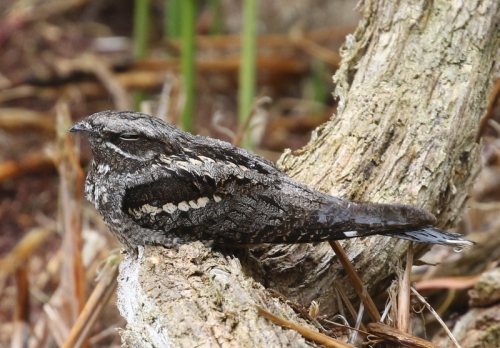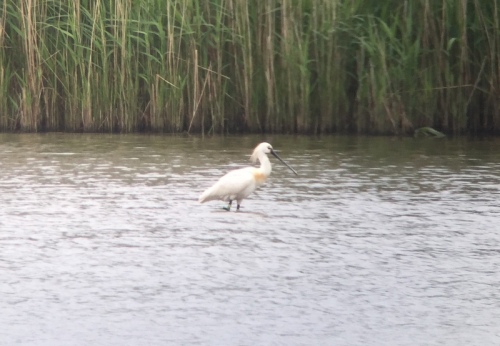My day started early at 5-00 arriving at Cley and turning down the lane to the shore. At the corner a Barn Owl flew on the the fence post carrying a large rat, it seemed to be finding it rather heavy, but hung on to it. It was cloudy, windy and drizzled not an ideal may morning. I ventured along the landward side of the shingle and looked over the reserve, not too much was happening due to the weather.
After a hearty breakfast at the hotel, I then met-up with Marcus Nash, he is a local bird and wildlife guide, and off to the east bank at Cley. There were lots of Sand Martins hawking for insects over the pools just beyond the car park, and many of them were stopping to perch in the reeds. The female Pochard was with ducklings, although I couldn’t see how many she had, as they kept tucked in to the reeds.
A couple of Sedge Warblers were still singing away and song flighting from the reeds beside the path, an occasional Reed Warbler was singing too. Across the Serpentine towards Pope’s Marsh, several Lapwings and their chicks, a single Ringed Plover was feeding on the open mud on the edge of the pool.
There were plenty of Avocets and Redshanks feeding and more Ringed Plovers were to be found. Over towards the back was a large group of Bar-tailed Godwits. Hiding in amongst them was a smaller single Knot.
A couple of adult Gannets just breaking the horizon also some distance offshore a Fulmar passed in the other direction, an occasional Sandwich Tern flew past just offshore. Walking back along the east bank a Bearded Tit flew up from the reedy ditch and out across the reed bed the other side.
A couple of adult Gannets just breaking the horizon also some distance offshore a Fulmar passed in the other direction, an occasional Sandwich Tern flew past just offshore. Walking back along the east bank a Bearded Tit flew up from the reedy ditch and out across the reed bed the other side.
Next stop was the Heath, heading to where a family of Dartford Warblers have been seen. A male Stonechat perched on the top of a dead tree, Yellowhammer and Linnet were singing, while a male Linnet removed a feacal sac from its nest.
Eventually small birds were seen flitting low in the gorse, Dartford Warblers. The adult Dartford Warblers were keeping down in cover, but eventually the male flew in and perched right on top of the gorse for a few seconds. Also, they were bring food to the fledglings that were low in the shelter of the gorse, and brief views were had.
A pair of Stock Doves were feeding out in the clearing. A pale male Stonechat perched up on the gorse, with three streaky juveniles hopping about on the low vegetation below, looking for food.
A dark shape looked out of place on a much paler stump. Stopping abruptly, we had a quick confirmatory look through binoculars and there in front of us was a Nightjar. I have never had such fantastic views of a Nightjar, it was awesome.

Photo courtesy of Marcus Nash
We stopped off at the local gull colony at Wells. . Scanning through the mass of Black-headed Gulls, we could see quite a few Mediterranean Gulls too.
A pair of Common Gulls and herring Gulls too and lots of terns were wheeling round over the colony. Three Sandwich Terns were chasing each other noisily, one of them had a small fish. A couple of Little Terns were fishing over the channel beyond, dwarfed by a nearby Common Tern.
In the harbour channel a pair of Great Crested Grebes diving. Down in a smaller side channel a drake Eider, it was catching small crabs.
Then off to Holkham grazing marshes and pine woods. There were lots of geese Greylags and Canada Geese, together with a good scattering of Egyptian Geese. Also a couple of Pink-footed Geese, these are injured birds which can not make the flight to there northern breeding grounds.
A couple of Spoonbills flew out east, and a steady flow of Little Egrets in and out too. here a great WHite Egret made an appearance flying on to the marshes, one had been wintering here. Swifts and House Martins zooming about low over the pools, the best place to look for insects in the cool and cloudy conditions. A male Marsh Harrier appeared from the reeds in front of us and flew slowly round before crashing back in. A flock of over 150 Black-tailed Godwits flew up from the marshes . A female Marsh Harrier flew up from the reeds and circled over, before chasing off a second Marsh Harrier which had drifted into the area.
A couple of Spoonbills flew out east, and a steady flow of Little Egrets in and out too. here a great WHite Egret made an appearance flying on to the marshes, one had been wintering here. Swifts and House Martins zooming about low over the pools, the best place to look for insects in the cool and cloudy conditions. A male Marsh Harrier appeared from the reeds in front of us and flew slowly round before crashing back in. A flock of over 150 Black-tailed Godwits flew up from the marshes . A female Marsh Harrier flew up from the reeds and circled over, before chasing off a second Marsh Harrier which had drifted into the area.
Several Spoonbills were circling over the trees from time to time. Another Spoonbill appeared on the pool, it was feeding.

Photo courtesy of Marcus Nash
Given a awful weather for a late May day I ended up having a fantastic day birding.






No comments:
Post a Comment